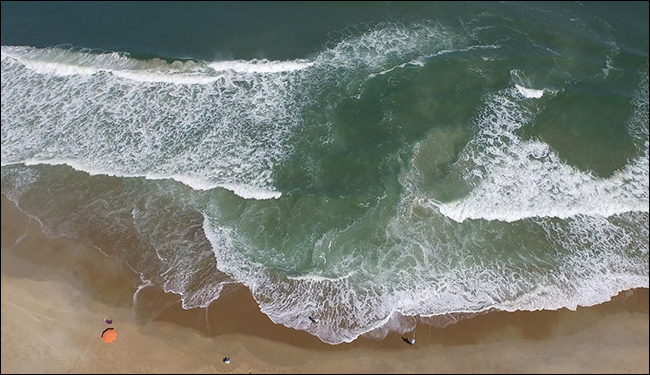
Rip currents are strong, narrow, seaward flows of water that extend from close to the shoreline to outside of the surf zone. They are found on almost any beach with breaking waves and act as “rivers of the sea,” moving sand, marine organisms, and other material offshore (see pictures below).
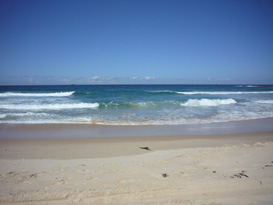 |
 |
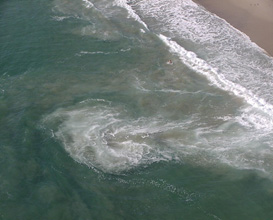 |
 |
|
Examples of different types of rip currents. The top panels show channelized rip currents as areas of darker water between regions of breaking waves and whitewater. The bottom panels show flash rip currents characterized by plumes of turbulent water and sand. See Sections 4 and 5 for more information about rip current types and how to identify them. Source: Top, R. Brander; bottom left = www.fire.lacounty.gov/lifeguard/rip-currents/; bottom right, Peter Davis |
|
Coastal scientists have been studying rip currents since the 1920s. While early studies were largely descriptive and qualitative, recent research has combined quantitative theoretical approaches, field experiments measuring waves and currents, remote video imaging, experiments in laboratory wave tanks, and computer model simulations.This research has focused on a variety of topics including rip current formation mechanisms, flow characteristics, and the hazard that rip currents pose to swimmers.The information here provides a brief description of our present understanding of the science of rip currents, along with a glossary of key scientific terms relating to rip currents and beaches. For more detailed information, a list of key scientific reviews of rip currents is provided below.
Rip currents are part of nearshore circulation cells that transport water between the surf zone and areas offshore. While rip current circulation patterns have some common features, the details of the structure of these currents can vary widely.
Breaking waves in the surf zone result in onshore movement of water and patterns of wave setup that drive longshore “feeder currents” flowing along the shoreline, converging and turning seaward to form a narrow and fast-flowing rip-neck. The rip-neck extends through the surf zone and outside of the breaking waves where it eventually decelerates and dissipates as an expanding rip-head. This water can then be transported shoreward again by breaking waves, completing the cell. In some cases the rip-neck is narrow and flows perpendicular to the beach and extends well beyond the surf zone (see figure below). In other cases, the rip may flow at an angle away from the beach, or may even meander.
Other rip currents are characterized by recirculating flow within the surf zone with only occasional exits of flow offshore (see figure below). Both types of circulation patterns exist and have significant implications for swimmer escape strategies and the transport of sand, larvae and water borne material.
 |
|
Rip current structure and different types of rip current circulation patterns showing both surf zone and offshore exchange via exiting flow (left) and re-circulation within the surf zone (right). Source: Castelle et al., 2016. |
Many different types of rip currents can occur on beaches in the United States and around the world. Scientists and beachgoers use a range of terms to describe these various rip currents types, and usage often is inconsistent. The following list of rip current types follows a scientific classification from Castelle et al. (2016) that differentiates rip currents based on their forcing mechanisms: the different causes of the alongshore variations in breaking waves that are crucial for the formation of rip currents.
Bathymetrically-controlled rip currents
The location and persistence of rip currents in many locations is controlled by the bathymetry, or shape of the bottom. This can mean the bathymetry near the beach, including sandbars that may shift in position and exhibit different configurations, or the offshore bathymetric features that are relatively fixed, including submarine canyons, submarine ridges, and reefs. Bathymetrically-controlled rip currents may be referred to as either channelized or focused:
Channelized rip currents are the most documented and well understood rip current type. They occupy deeper channels that interrupt shallow, mostly shore-parallel sandbars found on many beaches. They can persist in a relatively fixed location for days, weeks, or months and are relatively easy to identify (see figure below). Channelized rip currents typically range in width from 5 to 100 yards, have depths on the order of 3 to 10 feet or more, and may be spaced anywhere from 50 to 500 yards apart, with greater spacing often occurring for large wave heights.
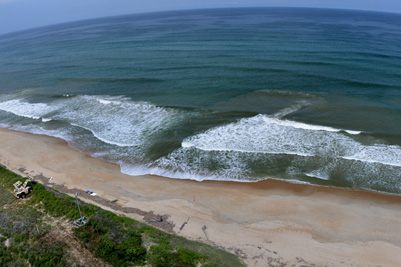 |
|
 |
|
|
Examples of channelized rip currents in the Outer Banks, NC (top), Marina Beach, CA (middle) and Pensacola Beach, FL (bottom). Source: M. Moulton (top); R. Brander (middle and bottom) |
|
The dominant visual characteristic of channelized rips is a narrow path of darker water between areas of whitewater associated with breaking waves ( see figure below). While the darker water appears seemingly calm, the surface is often characterized by a choppy, rippled texture. When channel rip currents remain in the same place for a long period of time, they can also erode the shoreline creating pronounced scallops, sometimes referred to as rip embayments or megacusps. Channelized rips have also been referred to as bar-gap, fixed, and accretionary rip currents.
Focused rip currents, like channel rips, also occur at relatively fixed locations, but are controlled by alongshore variations in breaking waves created by offshore bathymetric features such as submarine canyons, submerged ridges, or offshore sand bars. These features result in wave patterns that tend to focus wave breaking and rip current formation at a particular location. However, as the direction of wave approach changes, so too can the location of focused rip currents. Focused rip currents can occur along flat, featureless beaches where they typically appear as offshore directed plumes of turbulent water and sediment (see figure below).
 |
| An example of a focused rip current caused by offshore bathymetry at Blacks Beach, California. Source: Tom Cozad |
Rip currents often occur adjacent to man-made structures such as groins, jetties, and piers as well as natural geologic features such as headlands and rock/reef outcrops ( see figure below). These structurally-controlled rip currents are persistent in location and can occur even during small breaking wave conditions. Structural rips sometimes are associated with deeper water adjacent to structures, and in these cases appear as areas of darker water with reduced wave breaking activity.
Structural rips also have been referred to as boundary, topographic, permanent, and headland rip currents. They can be grouped into two types based on how and where they form. In some cases, these types can exist simultaneously on each side of the structure.
Shadow rip currents flow on the down-wave side of a rigid structure or boundary (i.e., the sheltered side). On straight beaches, the presence of a rigid obstacle creates alongshore variations in breaking waves due to the wave shadowing effect of the obstacle. Wave setup tends to be higher away from the structure due to larger waves, and lower closer to the structure due to smaller waves, as this region is more protected from wave energy. This pressure gradient forces water “downhill” in the alongshore direction back toward the obstacle and then offshore as a rip current alongside the obstacle (see figure below).
Deflection rip currents occur on the up-wave or exposed side of a rigid structure or boundary. On straight beaches, waves approaching and breaking against the shoreline at an angle can create strong alongshore currents that are physically deflected seaward when they reach the structure and flow offshore adjacent to it (see figure below).
 |
|
|
Examples of structural rip currents occurring adjacent to a groin (left) or rock reefs (right). Source: Maria Estella Carelli (left); R. Brander (right) |
|
As waves approach the shoreline, they usually break at an angle, generating a longshore current that flows along the shoreline (parallel) to the beach. When the longshore current (moving along the shore) encounters coastal structure (such as a groin, jetty, or pier) it is deflected in an offshore direction. This offshore-directed flow of water is called a rip current.
Hydrodynamically-Controlled Rip Currents
Unlike bathymetrically and boundary-controlled rip currents, some rip currents do not rely on the presence of nearshore or offshore bottom features or the presence of structures. These rip currents are controlled solely by hydrodynamics -- wave and current interactions -- and can occur on featureless straight beaches. It is not possible to predict the exact location and timing of hydrodynamic rip currents, but it may be possible to estimate the likelihood of their formation on a given beach.
There are several mechanisms by which hydrodynamic rips form. For example, waves originating from two different sources may approach the beach from different directions, and interference between the different wave trains causes higher breaking waves in some locations than in others. This variability in wave breaking leads to wave setup patterns that drive rip currents. In addition, waves that break in short sections, or “short-crested waves”, can drive small swirling flows or eddies that can merge to form “flash” or “transient” rip currents, lasting for several minutes. At other times, “shear instability” rip currents may form when eddies are shed off of longshore currents flowing along the beach as a result of waves breaking at an angle to the coast.
Hydrodynamically-controlled rip currents often present different visual characteristics than channelized rip currents and typically appear as narrow bands of turbulent whitewater and sand extending offshore of the surf zone ( see figure below). Less is known about their flow speed and duration due to a lack of field measurements; however, they still represent a risk to swimmers and waders due to their unpredictability and ability to carry people offshore into deeper water.
 |
 |
|
|
Examples of flash rips. The top photo shows turbulent water and sand exiting seaward under stormy conditions. The bottom photo shows a similar plume heading offshore during good weather. Both pictures are from Rehoboth Beach, DE. Source: R. Brander (top), Wendy Carey (bottom). |
||
While the best way to avoid getting caught in a rip current is always to swim near a lifeguard, however lifeguards are not everywhere at all times. Therefore a key aspect of being safe at a beach with breaking waves is to understand what rip currents are and how to avoid them by learning how to identify them.
The video below shows a channelized rip current. Note the area in the center of the video where there is a gap in the line of breaking waves. Also note the slightly discolored water, sand and foam traveling seaward past the breaking waves. Source: NOAA
The following list provides some tips on how to best spot rip currents:
 |
| A picture of a channelized rip current taken from an elevated position on the dune beach access in the Outer Banks, NC. Source: G. Dusek |
 |
 |
|
Two examples of channelized rip currents showing dark gaps in the lines of breaking waves. Source: R. Brander |
|
 |
|
A rip current indicated by choppy, rippled water in the location where there are gaps in the lines of breaking waves. Source: R. Brander |
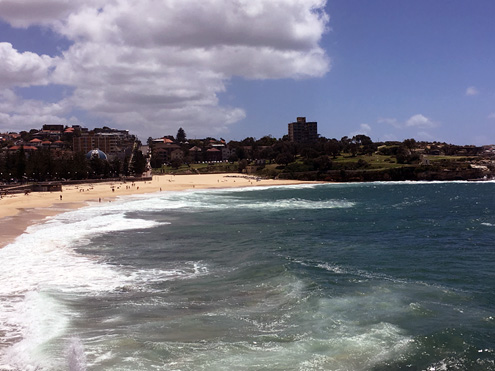 |
|
|
Rip currents (foreground and middle of photo) extending away from shore indicated by foam and sand traveling seaward, offshore of the breaking waves. Source: R. Brander |
 |
|
Channelized rip currents can stay in the same place for days or weeks and can erode out scalloped embayments in the beach like the one in the middle of the photograph (Source: Rob Brander). |
Rip currents can occur along any coastline with breaking waves.
Flow speed and behavior: Rip currents flow at speeds that can quickly transport unsuspecting swimmers considerable distances offshore. Channel rip currents typically flow about 1 to 2 feet per second and may reach speeds up to 8 feet per second! Even in weaker rip currents, it can be difficult to stand in place at waist depth against persistent flows and the combination of breaking waves and currents can be disorienting. The speeds of the strongest rips are on par with the top speeds of some of the fastest Olympic swimmers in history. Even for a strong swimmer, attempting to swim back to shore against the seaward flowing current can quickly result in exhaustion.
Not all parts of a rip current flow at the same speed. For example, in a classic rip current system, flow speeds gradually increase from the alongshore feeders and and peak about half way offshore in the rip-neck before eventually slowing down and stopping in the rip head. Similarly, rip flow speeds tend to be fastest toward the middle of the rip current and are at their maximum just below the surface of the water.
Rip pulsing: Rip current flow is also unsteady, which means it changes over time. A rip pulse is a sudden acceleration in flow speed that lasts for a short time period (30 seconds to a minute) and is associated with the breaking of incoming wave groups (sets of larger waves). When groups of large waves break, water depths can rapidly increase due to increased wave setup and unwary swimmers and waders can suddenly lose their footing, be swept into a rip current, and carried offshore by the subsequent rip current pulse. During rip pulses, the speed of the flow can more than double. It is extremely important to understand that changes in rip current speed can change rapidly with random increases in incoming wave heights and water levels. Rip pulses are often what lead to people getting in trouble in rip currents.
Tidal modulation: The speed and presence of rip currents on ocean beaches is related to the stage of the tide because the tide affects the amount of wave breaking, which is what drives rip currents. On beaches with a tide range of less than 6 feet, rip currents often flow faster about an hour or two on either side of low tide, when water levels are shallower and breaking wave activity is at its peak. Rips may stop flowing completely around high tide because the greater water depths can dramatically reduce the breaking wave activity and decrease any alongshore variations in wave setup or water level (see figure below)
On beaches with large tidal ranges, the tide may drop low enough that bars become exposed (dry) at low tide. In this case, rips shut off once the bars are exposed and the maximum rip speeds occur at mid tide, when the water level is low enough that there is strong wave breaking on the bars but not so low that the bar is dry. Regardless of the tidal range, rip currents have not been found to be stronger during a falling outgoing tide, versus a rising incoming tide; only the water level of the tide is important to controlling rips, not the direction of the tide.
 |
|
Wave breaking shown at the same location in Duck, NC at low and high tide on the same day. Note the wave breaking over the bar at low tide (left) driving rip currents compared to wave breaking only on shore at high tide (right) and no observable rips. Source: US Army Corps of Engineers Field Research Facility |
Rip currents are often incorrectly referred to as rip tides. Rip currents are not tides, so this term can cause confusion. Tides are a large-scale ocean process that typically leads to the slow rise and fall of water level over a period of 6-12 hours. Rip currents are not a rise and fall of water level, but rather concentrated currents that move water in a particular direction. As described in Section 6, the speed of rip current flow can be modulated by the level of the tide, which affects wave breaking.
Strong and concentrated currents often occur in tidal inlets, mouths of estuaries and harbor openings associated with both the incoming flood tide and outgoing ebb tide. While these currents can be very strong and also represent a hazard, they are best referred to as tidal currents rather than rip tides.
Rip Currents or Undertow? Rip currents are not the only way that water brought toward the shoreline by breaking waves is returned seaward. Offshore movement of water located close to the bottom also moves water out. This phenomenon is known as undertow or a near bed return flow. The term undertow has sometimes been used mistakenly to refer to rip currents and has contributed to the myth that rip currents can pull a person under the water. Undertow and rip currents are separate phenomena and neither will pull a person under the water! Undertow is usually slower than rip currents and typically does not present a hazard to swimmers.
For some swimmers in distress, the false sensation of being pulled under by a rip current results from a combination of panic, exhaustion, and being hit by breaking waves.
Undertow also is often confused with the backwash of broken waves at the shoreline. After a wave breaks and runs up the beach face, the returning water is called backwash and can be quite strong, particularly on steep beaches and in the embayments of beach cusps. While this backwash will not carry water very far offshore, it can be strong enough to knock people over, particularly small children and the elderly, and carry them into deeper water.
Collapsing Sandbars? Some mass rescue events and fatal drownings have been incorrectly attributed to the collapse of a sandbar, which suddenly left waders in deeper water. Sandbars do not collapse. Sandbars are large masses of sand and while they do shift in location, this is a slow and gradual process taking days to months under normal conditions, or as short as several hours during a large storm. In many cases, the real cause of swimmer distress in these situations is a group of larger waves, which causes a small rise in water level (wave setup), causing waders to lose footing. This is often associated with a rip current pulse or increase in flow speed as described in Section 6, which can present a further hazard.
A number of excellent reviews of rip currents exist in the scientific literature that provide a more detailed overview of the material provided on this site:
This review was created by Dr. Gregory Dusek (NOAA National Ocean Service), Dr. Melissa Moulton (University of Washington, APL) and Dr. Rob Brander (UNSW Sydney) in July 2018.